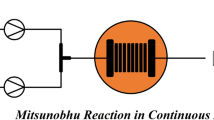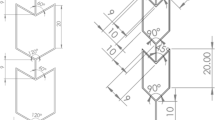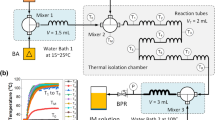Abstract
Customized flow equipment was utilized to develop and optimize the halo-amine coupling reaction. In this study, the development work was conducted through the statistical design of experiments (DoE) approach via a 2-factor interaction model. Experiments were conducted in two different reactor designs such as packed bed (type 1) and tubular reactor (type 2) set up. The effect of molar ratios of 4-methoxyaniline (1) and 1-(bromomethyl)-4-nitrobenzene (2), temperature, residence time, and base equivalence of N, N-Diisopropylethylamine were studied in detail. The data generated was in good agreement with significant improvements that were achieved in the overall reaction time and selectivity towards the desired product as compared to the batch process. The halo-amine coupling reaction in batch condition would take on an average of 90 to 120 min, which was effectively accomplished in 6 to 9 mins in both the flow reactor types. The advantage of type 2 over type 1 was found to be better towards the selectivity of the desired product with minimized impurities. A certain degree of back-mixing in the type 1 reactor was observed, which led to an increase in the impurity formation, whereas these impurities were practically less formed in the type 2 reactor. The reaction model is in good agreement with the reaction conditions.

Graphical abstract








Similar content being viewed by others
Change history
06 October 2020
This erratum is published as author affiliation was overlooked during proofing Dayanand Sagar College of Engineering needs to be correctly read as: Dayananda Sagar College of Engineering.
References
Fitzpatrick, D. E., Battilocchio, C., & Ley, S. V. (2016). Enabling technologies for the future of chemical synthesis. Central Science (3), 131–138.
Wiles, C., & Watts, P. (2016). Micro reaction technology in organic synthesis. CRC Press.
Watts, P., & Wiles, C. (2007). Recent advances in synthetic micro reaction technology. Chemical communications, (5), 443–467.
Pennemann, H., Hessel, V., & Löwe, H. (2004). Chemical microprocess technology—from laboratory-scale to production. Chemical Engineering Science, 59(22-23), 4789-4794.
Geyer, K., Gustafsson, T., & Seeberger, P. H. (2009). Developing continuous-flow microreactors as tools for synthetic chemists. Synlett, 2009(15), 2382–2391.
Jensen, K. F. (2001). Microreaction engineering—is small better? Chemical Engineering Science, 56(2), 293–303.
Caron, S., & Thomson, N. M. (2015). Pharmaceutical process chemistry: Evolution of a contemporary data-rich laboratory environment. The Journal of Organic Chemistry, 80(6), 2943–2958.
Benali, O., Deal, M., Farrant, E., Tapolczay, D., & Wheeler, R. (2008). Continuous flow microwave-assisted reaction optimization and scale-up using fluorous spacer technology. Organic Process Research & Development, 12(5), 1007–1011
Roberge, D. M., Ducry, L., Bieler, N., Cretton, P., & Zimmermann, B. (2005). Microreactor technology: a revolution for the fine chemical and pharmaceutical industries? Chemical Engineering & Technology: Industrial Chemistry‐Plant Equipment‐Process Engineering‐Biotechnology, 28(3), 318–323.
Kockmann, N., Gottsponer, M., Zimmermann, B., & Roberge, D. M. (2008). Enabling continuous‐flow chemistry in microstructured devices for pharmaceutical and fine‐chemical production. Chemistry–A European Journal, 14(25), 7470-7477.
Bogdan, A. R., Poe, S. L., Kubis, D. C., Broadwater, S. J., & McQuade, D. T. (2009). The continuous‐flow synthesis of ibuprofen. Angewandte Chemie International Edition, 48(45), 8547–8550.
Herath, A., Dahl, R., & Cosford, N. D. (2010). Fully automated continuous flow synthesis of highly functionalized imidazo [1, 2-a] heterocycles. Organic Letters, 12(3), 412–415.
Hartman, R. L., & Jensen, K. F. (2009). Microchemical systems for continuous-flow synthesis. Lab on a Chip, 9(17), 2495–2507.
Jähnisch, K., Hessel, V., Löwe, H., & Baerns, M. (2004). Chemistry in microstructured reactors. Angewandte Chemie International Edition, 43(4), 406–446.
Delville, M. M., Nieuwland, P. J., Janssen, P., Koch, K., van Hest, J. C., & Rutjes, F. P. (2011). Continuous flow azide formation: Optimization and scale-up. Chemical Engineering Journal, 167(2–3), 556–559.
Geyer, K., Codee, J. D., & Seeberger, P. H. (2006). Microreactors as tools for synthetic chemists—the chemists' round‐bottomed flask of the 21st century? Chemistry–A European Journal, 12(33), 8434–8442.
Nieuwland, P. J. (2012). Organic synthesis in microreactors: development of continuous flow optimisation and scale-up strategies., Nijmegen: Doctoral dissertation, Radboud university.
Nieuwland, P. J., Koch, K., van Harskamp, N., Wehrens, R., van Hest, J. C., & Rutjes, F. P. (2010). Flash Chemistry Extensively Optimized: High‐Temperature Swern–Moffatt Oxidation in an Automated Microreactor Platform. Chemistry–An Asian Journal, 5(4), 799–805.
Nagaki, A., Kim, H., Usutani, H., Matsuo, C., & Yoshida, J. I. (2010). Generation and reaction of cyano-substituted aryllithium compounds using microreactors. Organic & Biomolecular Chemistry, 8(5), 1212–1217.
Hafner, A., Filipponi, P., Piccioni, L., Meisenbach, M., Schenkel, B., Venturoni, F., & Sedelmeier, J. (2016). A simple scale-up strategy for organolithium chemistry in flow mode: from feasibility to kilogram quantities. Organic Process Research & Development, 20(10), 1833–1837.
Zhang, C., Zhang, J., & Luo, G. (2016). Kinetic study and intensification of acetyl guaiacol nitration with nitric acid—acetic acid system in a microreactor. Journal of Flow Chemistry, 6(4), 309–314.
Anxionnaz, Z., Cabassud, M., Gourdon, C., & Tochon, P. (2008). Heat exchanger/reactors (HEX reactors): concepts, technologies: state-of-the-art. Chemical Engineering and Processing: Process Intensification, 47(12), 2029–2050.
Koch, K., van Weerdenburg, B. J., Verkade, J. M., Nieuwland, P. J., Rutjes, F. P., & van Hest, J. C. (2009). Optimizing the deprotection of the amine protecting p-methoxyphenyl group in an automated microreactor platform. Organic Process Research & Development, 13(5), 1003–1006.
Becker, R., van den Broek, S. B. A., Nieuwland, P. J., Koch, K., & Rutjes, F. P. (2012). Optimisation and scale-up of α-bromination of acetophenone in a continuous flow microreactor. Journal of Flow Chemistry, 2(3), 87–91.
Fabry, D. C., Sugiono, E., Rueping, M., & Meunier, F. C. (2016). Reaction Chemistry & Engineering. Chemical Engineering, 1, 165.
Gioiello, A., Mancino, V., Filipponi, P., Mostarda, S., & Cerra, B. (2016). Concepts and optimization strategies of experimental design in continuous-flow processing. Journal of Flow Chemistry, 6(3), 167–180.
Nunn, C., DiPietro, A., Hodnett, N., Sun, P., & Wells, K. M. (2018). High-throughput automated design of experiment (DoE) and kinetic modeling to aid in process development of an API. Organic Process Research & Development, 22(1), 54–61.
Afzal, A., Muhammad, I. A., Muhammad, Y., Hayat, K., & Mansoor, U. H. S. (2013). A comparative study of alkaline hydrolysis of ethyl acetate using design of experiments, Iranian Journal of Chemistry and Chemical Engineering, 32(4), 33–47.
Asprey, S. P., & Macchietto, S. (2000). Statistical tools for optimal dynamic model building. Computers & Chemical Engineering, 24(2–7), 1261–1267.
Montgomery, D. C. (2017). Design and analysis of experiments. John Wiley & Sons.
Lazic, Z. R. (2006). Design of experiments in chemical engineering: a practical guide. John Wiley & Sons.
Franceschini, G., & Macchietto, S. (2008). Model-based design of experiments for parameter precision: State of the art. Chemical Engineering Science, 63(19), 4846–4872.
Atkinson, A. C., Bogacka, B., & Bogacki, M. B. (1998). D-and T-optimum designs for the kinetics of a reversible chemical reaction. Chemometrics and Intelligent Laboratory Systems, 43(1–2), 185–198.
Condra, L. (2001). Reliability improvement with design of experiment. CRC Press.
Acknowledgments
The authors would like to acknowledge and thank Dr. Jegadeesh Thampi, BU-Head, Chemical Development, Syngene International Ltd., and Dr. Narendra Ambhaikar, Head-PRD, Chemical Development, Syngene International Ltd, for providing adequate support, guidance and motivation throughout the work.
Funding
This work was supported by Syngene International Ltd, Bengaluru, India and all the necessary approvals are in place to publish the same.
Author information
Authors and Affiliations
Corresponding authors
Ethics declarations
Competing interests
The authors declare that they have no competing interests.
Availability of data and material
The data supporting to the results and conclusion are included in this article. Any queries regarding data may be directed to corresponding author.
Data transparency
Author’s confirm that the paper now submitted is not copied or plagiarized version of some other published work.
Additional information
Publisher’s note
Springer Nature remains neutral with regard to jurisdictional claims in published maps and institutional affiliations.
Highlights
• Development of halo-amine coupling reaction in continuous flow.
• Optimization of halo-amine coupling through the statistical design of experiments approach.
• Different reactor designs such as packed bed and tubular reactor were tested effectively.
• Successfully transformed from a known batch procedure to a continuous flow process with significant time reduction and improved selectivity.
Electronic supplementary material
ESM 1
(DOCX 2.6 mb)
Rights and permissions
About this article
Cite this article
Basavaraju, G., Lydia, S. & Rajanna, R. Flow process development and optimization of halo-amine coupling through customized flow processing equipment using DoE approach. J Flow Chem 10, 571–582 (2020). https://doi.org/10.1007/s41981-020-00099-1
Received:
Accepted:
Published:
Issue Date:
DOI: https://doi.org/10.1007/s41981-020-00099-1




